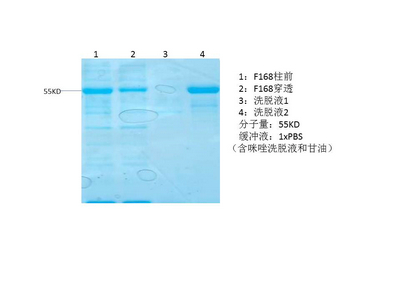- Home
- About
- Promotions
-
Products
-
Elisa Kits
- |
-
Primary antibodies
- |
-
Secondary antibodies
- |
-
Proteins
- |
-
IHC reagents
- |
-
WB reagents
- PonceauS Staining Solution
- PBST Washing Buffer, 10X
- 1.5M Tris-HCl Buffer, pH8.8
- 1M Tris-HCl Buffer, pH6.8
- 10% SDS Solution
- Prestained Protein Marker
- TBST Washing Buffer, 10X
- SDS PAGE Loading Buffer, 5X
- Stripping Buffered Solution
- Tris Buffer, pH7.4, 10X
- Total Protein Extraction Kit
- Running Buffer, 10X
- Transfer Buffer, 10X
- 30% Acr-Bis(29:1) Solution
- Tris电泳液速溶颗粒
- PBS(1X, premixed powder)
- TBS(1X, premixed powder)
- 快速封闭液
- 转膜液速溶颗粒
- Chemical reagents
- News
- Distributor
- Resources
- Contact
- Home
- >
- Info
- >
- IκB-α protein
- >
- Go Back
IκB-α protein
- Catalog No.:YD0050
- Applications:WB;SDS-PAGE
- Reactivity:Human
- Protein Name:
- IKB a protein
- Sequence:
- Amino acid: 1-77, with his-MBP tag.
- Formulation:
- Liquid in PBS
- Concentration:
- SDS-PAGE >90%
- Storage Stability:
- -20°C/6 month,-80°C for long storage
- Other Name:
- NF-kappa-B inhibitor alpha (I-kappa-B-alpha) (IkB-alpha) (IkappaBalpha) (Major histocompatibility complex enhancer-binding protein MAD3)
- Background:
- disease:Defects in NFKBIA are the cause of ectodermal dysplasia anhidrotic with T-cell immunodeficiency autosomal dominant (ADEDAID) [MIM:612132]. Ectodermal dysplasia defines a heterogeneous group of disorders due to abnormal development of two or more ectodermal structures. ADEDAID is an ectodermal dysplasia associated with decreased production of pro-inflammatory cytokines and certain interferons, rendering patients susceptible to infection.,function:Inhibits the activity of dimeric NF-kappa-B/REL complexes by trapping REL dimers in the cytoplasm through masking of their nuclear localization signals. On cellular stimulation by immune and proinflammatory responses, becomes phosphorylated promoting ubiquitination and degradation, enabling the dimeric RELA to tranlocate to the nucleus and activate transcription.,induction:Induced in adherent monocytes.,online information:NFKBIA mutation db,PTM:Phosphorylated; disables inhibition of NF-kappa-B DNA-binding activity.,PTM:Sumoylated; sumoylation requires the presence of the nuclear import signal.,PTM:Ubiquitinated; subsequent to stimulus-dependent phosphorylation on serines.,similarity:Belongs to the NF-kappa-B inhibitor family.,similarity:Contains 5 ANK repeats.,subcellular location:Shuttles between the nucleus and the cytoplasm by a nuclear localization signal (NLS) and a CRM1-dependent nuclear export.,subunit:Interacts with RELA; the interaction requires the nuclear import signal. Interacts with NKIRAS1 and NKIRAS2. Part of a 70-90 kDa complex at least consisting of CHUK, IKBKB, NFKBIA, RELA, IKBKAP and MAP3K14. Interacts with HBV protein X. Interacts with RWDD3; the interaction enhances sumoylation.,
- Function:
- protein import into nucleus, translocation, activation of innate immune response, pattern recognition receptor signaling pathway, toll-like receptor signaling pathway, response to molecule of bacterial origin, activation of immune response, positive regulation of immune system process, immune response-activating signal transduction, innate immune response-activating signal transduction, immune response-regulating signal transduction, regulation of transcription, DNA-dependent, regulation of transcription from RNA polymerase II promoter, protein targeting, protein import into nucleus, intracellular protein transport, nucleocytoplasmic transport, apoptosis, anti-apoptosis, cell surface receptor linked signal transduction, intracellular signaling cascade, protein kinase cascade, I-kappaB kinase/NF-kappaB cascade, cytoplasmic sequestering of NF-kappaB, protein localization, cell death, regul
- Subcellular Location:
- Cytoplasm. Nucleus. Shuttles between the nucleus and the cytoplasm by a nuclear localization signal (NLS) and a CRM1-dependent nuclear export. .




